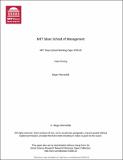Class Pricing
Author(s)
Wernerfelt, Birger
DownloadSSRN-id1084113.pdf (218.0Kb)
Metadata
Show full item recordAbstract
A contract with K-class pricing divides a large set of goods or services into K classes and assigns a single price to any element of a class. Class pricing can be efficient when several different versions may be traded and it is costly to assign individual prices to all of them. It is more likely to be used when the number of buyers is smaller, the number of versions is larger, the variance in costs is smaller, and demand ex ante differs less between versions. Under simple conditions classes should be designed to minimize the sum of squared within-class cost deviations. In bilateral trades, the most efficient game form is that in which classes are designed by the player with less varied gains from trade, while the traded version is chosen by the other player. Decisions are thus made by the player who cares most about them, while the opponent prescribes a set of limits.
Date issued
2008-01-15Publisher
Cambridge, MA; Alfred P. Sloan School of Management, Massachusetts Institute of Technology
Series/Report no.
MIT Sloan Working Paper;4765-09